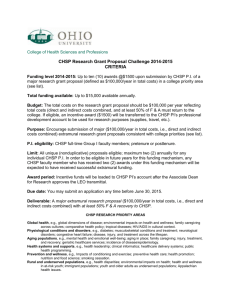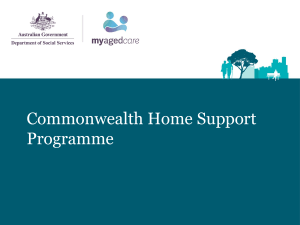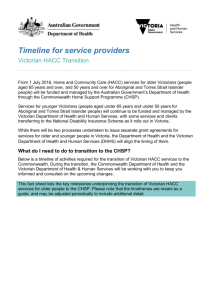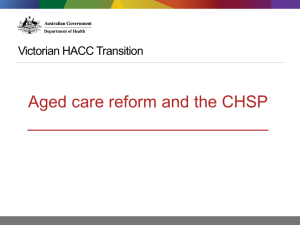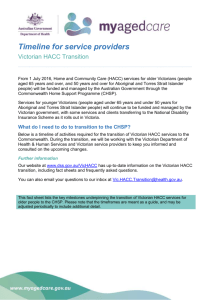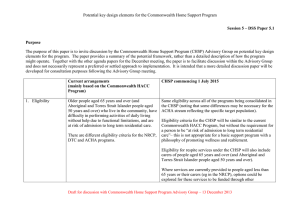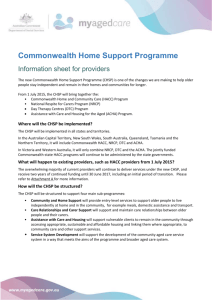Commonwealth Home Care Support Presentation of 1 July 2015
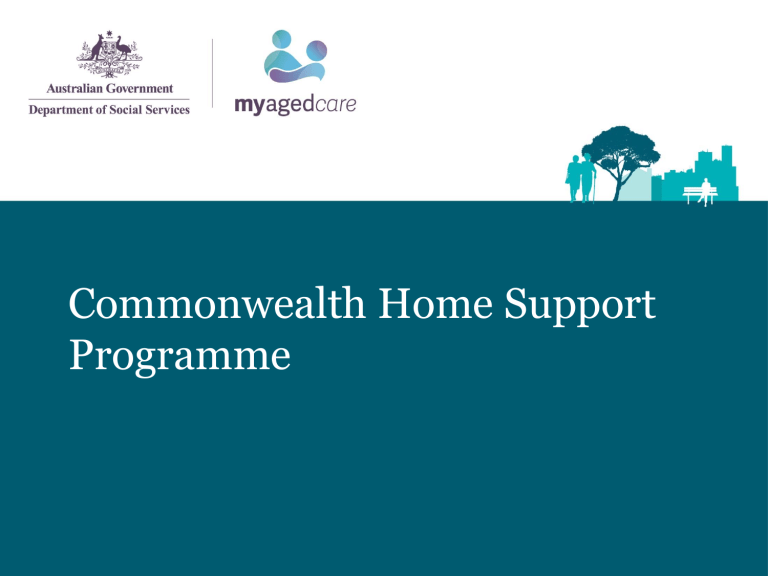
Commonwealth Home Support
Programme
Today’s Presentation
Module 1
• Introduction to the CHSP – what are we trying to achieve?
• Recap of the development process
• Entry and assessment through My Aged Care
• Consultation opportunities - Manual, Fees and
Restorative Care Approaches
Module 2
• Operational detail of the programme
• Implementation timelines
• Next steps
Introduction to the CHSP
Highlights of the CHSP
• 2015-16 will represent $1.7 billion funding per annum
• Continued support to over 550,000 older Australians
• Will address fragmentation of current aged care system which is:
• complex for providers to operate
• difficult for consumers to navigate
What it all means
What it means for clients
• Continuity of care and support
• streamlined entry-level support services
• Entry and assessment through My Aged Care
• support with a restorative approach (incorporating wellness and reablement)
• equity and sustainability through a national fees policy
What it means for providers
• Lots of stability including continued funding for majority of providers and continuity of care for existing clients
• Reduced red tape for providers by streamlining funding arrangements
CHSP does not currently apply to HACC services in Western
Australia and Victoria
Development Process
Key Inputs
Expert advice from NACA
Commonwealth HACC
Service group reviews
Review of respite arrangements
Sector feedback on the
Discussion Paper
Key Outcomes
Programme position
Programme philosophies
Programme framework
Access to the CHSP and interactions with other programmes
Post Discussion Paper
Key design changes since the Discussion Paper:
• Introducing a transition period to support transition to the
CHSP
• Describing CHSP services as ‘ entry level ’ rather than
‘basic’
• Support for grandfathering arrangements for existing clients
• Programme Framework based on target groups not outcomes
Positioning of CHSP
Home Care Package (3&4)
High intensity care at home
Home Care Package (1&2)
Low intensity care at home for clients with more complex needs requiring ongoing care coordination and/or case management
Flexible Care Residential care
Commonwealth Home Support Programme
Low intensity entry-level support at home
Short-term restorative care
Ongoing services for clients and/or carers
My Aged Care
Identifiable entry point, providing consistent information, starndardised assessment procedures and linking service capability
Programme Philosophies
Restorative Care Approaches (including wellness and reablement)
• Three different yet complementary methods of intervention
• The CHSP Good Practice Guide will help providers understand and implement concepts
Consumer direction
• Works in partnership with a wellness approach
• Empowers individuals to take charge of decision making about their care and services
• Does not provide individual budgets
Structure of the CHSP
The CHSP is structured around four main subprogrammes based on target groups:
• Community and Home Support
• Care Relationships and Carer Support
• Assistance with Care and Housing
• Service System Development
Sub - Programmes
Community and Home Support
Objective To provide entry-level support services to assist older people to live independently at home and in the community
Target Group Frail, older people aged 65 years and over (or 50 years and over for Aboriginal and Torres Strait Islander peoples) who need assistance with daily living to remain living independently at home and in the community
Service types funded
Meals
Other Food Services
Transport
Domestic Assistance
Personal Care
Home Maintenance
Home Modifications
Social Support-Individual
Social Support-Group
(formerly Centre-Based
Day Care).
Nursing
Allied Health and Therapy
Services
Goods, Equipment and
Assistive Technology
Sub - Programmes
Care Relationships and Carer Support
Objective
Target Group
Service types funded
To support and maintain care relationships between carers and clients, through providing good quality respite care for frail, older people so that their regular carer can take a break
.
Frail, older clients will be the recipients of planned respite services
Flexible Respite:
In-home day respite
In-home overnight respite
Community access – individual
Host family day respite
Host family overnight respite
Mobile respite
Other planned respite
Centre-based respite:
Centre based day respite
Residential day respite
Community accessgroup respite
Cottage respite (Overnight community)
Sub - Programmes
Assistance with Care and Housing
Objective To support vulnerable clients to remain in the community through accessing appropriate, sustainable and affordable housing and linking them where appropriate, to community care and other support services
Target Group
Service types funded
People aged 50 years and over who are on a low income and are homeless or at risk of homelessness as a result of experiencing housing stress or not having secure accommodation
Assistance with Care and Housing
Sub - Programmes
Service System Development
Objective To support the development of the community aged care service system in a way that meets the aims of the programme and broader aged care system
Target Group Grant recipients funded under the Commonwealth
Home Support Programme and their client base
Service types funded Sector Support and Development activities in identified target areas
Special Needs Groups
• CHSP special needs groups align with the Aged Care Act
1997
• Care and support of people with dementia is core business for all providers
Entry and Assessment
New capabilities of My Aged Care
• Entry and assessment for new clients to the CHSP through My Aged Care
• Reassessment of existing clients through My Aged Care only if significant change in care needs
• Service level assessment will remain the provider’s responsibility
Consultation Opportunities
Programme Manual
Fees Consultation Paper
• Available for feedback at www.dss.gov.au/chsp
• Providers are encouraged to work with peak bodies for a consolidated response
• Closes mid-April 2015 .
Good Practice Guide • Available for feedback at www.dss.gov.au/chsp
• Closes mid-April 2015.
Programme Manual
The CHSP Programme Manual forms part of your
Grant Agreement. It outlines the operational and administrative requirements of the CHSP and is structured in two parts.
Part A
Outlines the delivery of the
CHSP services including operational requirements
Part B
Outlines obligations for the administration of the CHSP, including funding and reporting arrangements
CHSP Fees Policy
The CHSP fees policy will aim to:
• provide a fairer, nationally consistent framework for the collection of fees
• ensure clients make a contribution to the cost of their care based on their capacity to pay
• have appropriate safeguards for those least able to contribute to the cost of their care
• address the financial disincentives for clients to move to a different programme better suited to meet their care needs
Good Practice Guide
• The CHSP Good Practice Guide will help providers understand and implement wellness, reablement and restorative care concepts
• The Guide is available at www.dss.gov.au/chsp for your feedback.
• Feedback closes mid-April 2015.
Questions
Operational details of the CHSP
Most operational changes are line with DSS’s new way of working for grants including:
• Quality
• Reporting
• Funding/Flexibility
Operational details of the CHSP contd.
Quality Arrangements
Providers must comply with the:
• Home Care Standards
• Guidelines for the Aged Care Complaints Scheme
Reporting Arrangements
Financial Reporting for acquittal of funds submitted annually
Performance Reporting every 6 monthly
Quality Reporting by Australian Aged Care Quality Agency
Operational details of the CHSP contd.
Funding Flexibility
• Providers must deliver no less than 80% of the outputs for each funded service type listed in the Program Schedule
• Providers can use remaining 20% to support the delivery of other needed services within the same Sub-Programme
• Providers must seek the Department’s approval to use more than
20% flexibility
Interfaces with other Programmes
• Home Care Packages
• Residential Care
• NDIS
Reduction in Red Tape
PROGRAMME
FRAMEWORK
Four programmes consolidated all into one programme
GRANT AGREEMENT Departments Standard Comprehensive Grant
Agreement including Supplementary Conditions
One Schedule
SPECIFIC
REQUIREMENTS
PAYMENTS
FINANCIAL
REPORTING
Grant recipients must keep a register of their subcontractors to be provided to Department only upon request
Quarterly (every 3 months).
An annual report on fees will be required (not part of financial acquittal process).
PERFORMANCE 6 monthly reporting
REPORTING
QUALITY REPORTING Grant recipients delivering care services operate in line with Home Care Standards however only direct care services will be subject to Quality reporting
Transition period
Commonwealth Home Support Transition Period commences from 1 July 2015:
• Majority of existing agreements will be extended to
31 October 2015
• Existing guidelines and manuals for the Commonwealth
HACC Program, NRCP, ACHA and DTC will continue to be used during this transition
• Providers will receive more information shortly
What do providers need to do?
• Continue to deliver services in line their existing agreements
• Talk to their grant manager if they have any questions
CHSP Grant Agreements
Establishment of new CHSP Grant Agreements
•
• We will work with you to establish agreements to commence from 1 November 2015 – 30 June 2017
From 1 November, you will must comply with:
Grant Agreement & terms and conditions
CHSP Programme Manual & Guidelines
What do providers need to do?
• Follow advice received in coming months
Where to from here?
What’s happening now?
Consultation on draft Programme Manual, Fees Consultation Paper and Good Practice Guide
Stage 1 What’s happening from 1 July 2015?
Commonwealth Home Support Transition Period
Commencement of the My Aged Care Regional Assessment Service
Establishment of new CHSP Grant Agreements
Stage 2 What’s happening from 1 November 2015?
Commencement of new CHSP Grant Agreements


